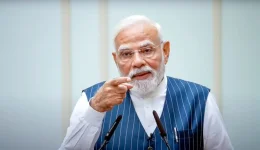
Prime Minister Narendra Modi, on Wednesday, underscored the significant economic impact of India's burgeoning naval shipbuilding program, stating that the ongoing construction of 60 naval vessels is projected to generate an economic circulation of approximately ₹3 trillion (approximately $36 billion USD).
The Prime Minister made these remarks during the commissioning ceremony of three new warships – INS Surat, INS Nilgiri, and INS Vaghsheer – at the Naval Dockyard in Mumbai, marking the first instance of three major warships being commissioned simultaneously, all built domestically.
The construction of these 60 ships, valued at around ₹1.5 trillion (approximately $18 billion USD), is anticipated to create a substantial employment multiplier effect. According to the Prime Minister, each vessel's construction generates up to 14,000 direct and indirect jobs. This translates to a potential total of 8,40,000 jobs across the shipbuilding program, with a significant portion benefiting the Micro, Small, and Medium Enterprises (MSME) sector, which supplies most of the ships' components.
This aligns with the Modi government's "Make in India" initiative, aimed at bolstering domestic manufacturing and reducing reliance on imports. The Ministry of Defence (MoD) estimates that every rupee invested in shipbuilding generates nearly double the economic impact, amplifying the initiative's significance.
"The 'Make in India' initiative is not only enhancing the capabilities of India's armed forces but also opening new avenues for economic progress," Prime Minister Modi stated, emphasizing the broader economic benefits beyond defence. He highlighted that experts estimate that for every rupee invested in shipbuilding there is nearly double the economic impact.
The Prime Minister also highlighted India's strides towards self-reliance in defence, or "Aatmanirbharta." He noted that the armed forces have identified over 5,000 items and equipment that will no longer be imported.
This push towards indigenization is further supported by the establishment of India's largest helicopter manufacturing facility in Karnataka, a transport aircraft factory, and defence corridors in Uttar Pradesh and Tamil Nadu.
The Indian Navy's commitment to "Make in India" is evident in the addition of 33 ships and seven submarines over the past decade. Furthermore, 39 out of the 40 current naval vessels are being built in Indian shipyards.
India has set ambitious targets for its defence sector. Annual domestic defence production has surpassed ₹1.25 trillion, and military equipment exports now reach over 100 countries.
The success of domestically built platforms like the INS Vikrant aircraft carrier and the INS Arihant and INS Arighaat nuclear submarines underscores India's growing capabilities in this field. As of December 2023, the Indian Navy had 60 vessels under construction in Indian shipyards, reflecting a significant investment in naval modernization.
The newly commissioned warships represent the latest advancements in India's naval technology. INS Surat, the fourth and final Project 15B guided-missile destroyer, boasts 75% indigenous content and advanced weaponry.
INS Nilgiri, the first of the Project 17A stealth frigates, features enhanced survivability and stealth capabilities. INS Vaghsheer, the sixth and final Project 75 Scorpene-class submarine, is a product of collaboration with France's Naval Group and showcases India's growing expertise in submarine construction.
The Scorpene-class submarines are known for their advanced stealth features, including superior acoustic silencing techniques, making them difficult to detect underwater.
Defence Minister Rajnath Singh, also present at the ceremony, hailed the commissioning as a testament to the growing strength of the Indian Navy and the nation's presence in the Indian Ocean Region. He reiterated the MoD's commitment to self-reliance, noting that over 75% of the content in INS Surat and INS Nilgiri is indigenous.
The MoD has designated 2025 as the 'Year of Reforms', with plans to streamline the Defence Acquisition Procedure (DAP) 2020 to facilitate faster and more robust capability development.
These developments are part of India's broader strategy to modernize its military for the 21st century. This includes ongoing reforms like the creation of the Chief of Defence Staff and the move towards integrated theatre commands to enhance operational efficiency. These reforms aim to streamline decision-making and improve coordination among the different branches of the military.
The Indian government's focus on indigenous defence production and naval modernization aligns with its strategic goals of projecting power in the Indian Ocean Region and safeguarding its maritime interests. This strategy is also reflected in India's increasing defence budget, which has seen a steady rise in recent years. India was the world's third-largest military spender in 2023.



